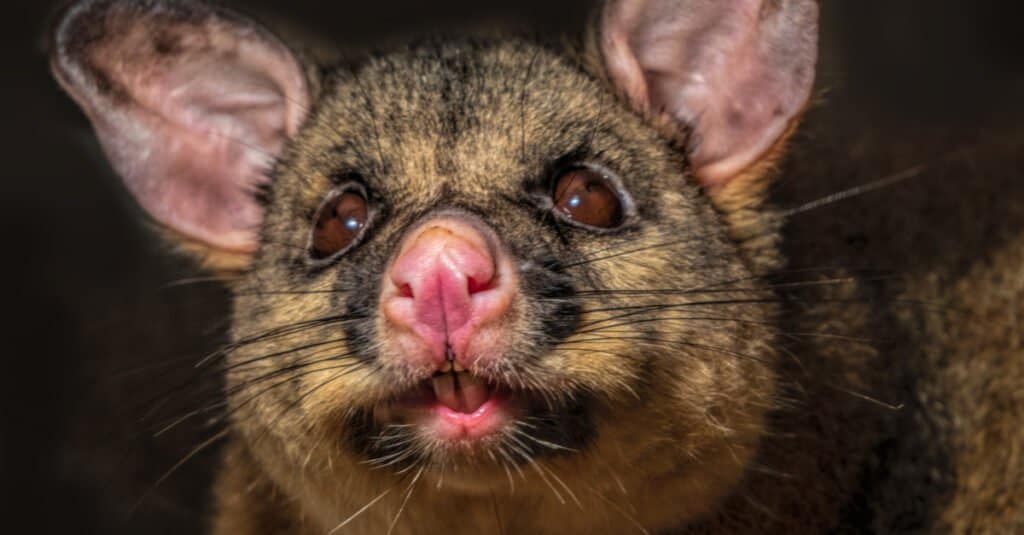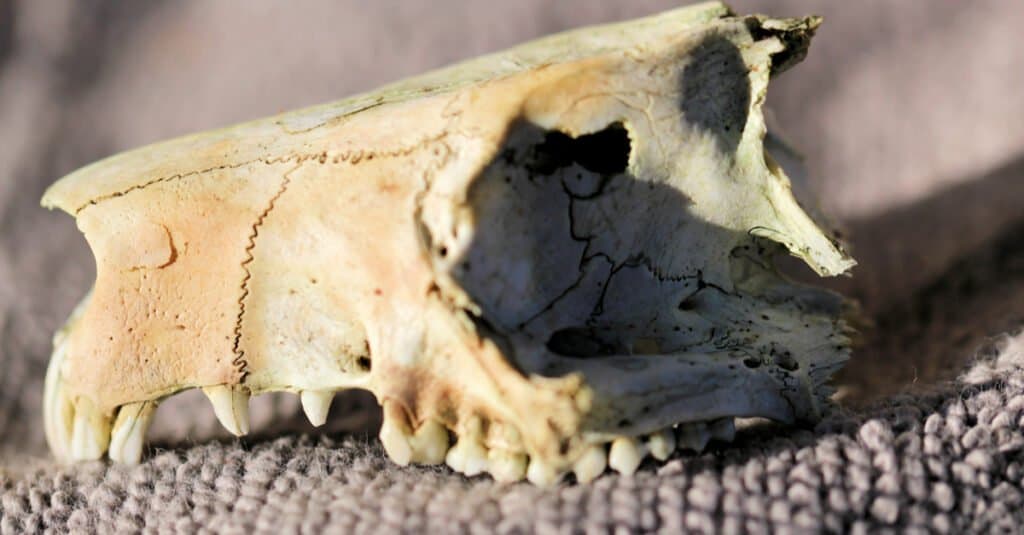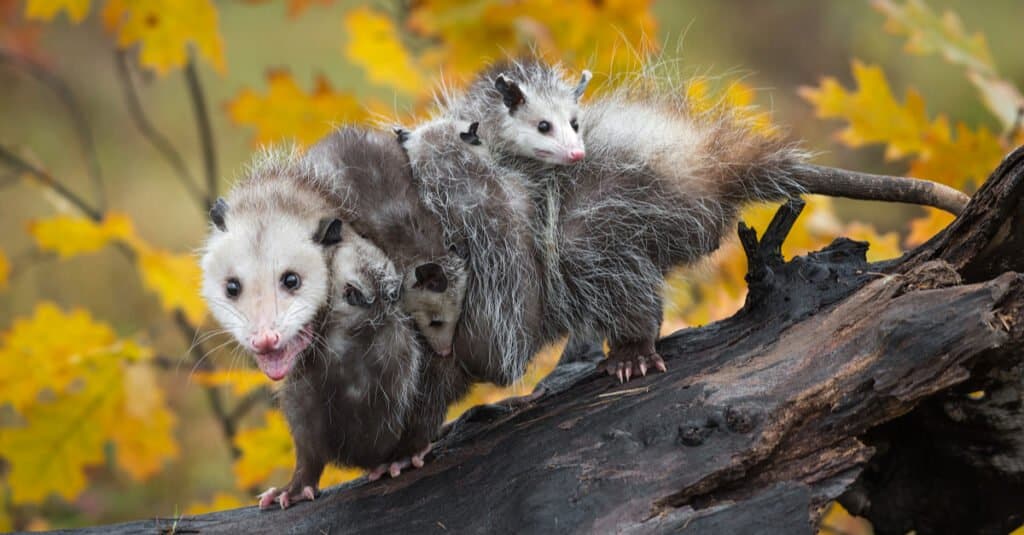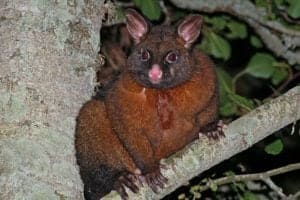If you’ve ever seen a picture of a possum with its mouth gaping wide, you’ll know they have an impressive set of shiny whites. Judging by those pictures, possum teeth are no joke. With the prevalence of possum pests in urban areas, it leaves a lot of people wondering: do possums bite? Read on to find out whether you have anything to fear from these curious little marsupials!
What is a Possum?

The common brushtail possum is native to Australia, and the second largest of the possums
©Timothy Christianto/Shutterstock.com
Possums are marsupials, a type of mammal inhabiting Australia and the surrounding islands. These islands include New Zealand, Papua New Guinea, Tasmania, and the Solomon Islands. Though the term “possum” may also refer to marsupials inhabiting North, Central, and South America, the proper term for these animals is “opossum.” This includes the Virginia opossum, the only marsupial in North America. For the purposes of this article, “possum” refers to both kinds of marsupials except when otherwise specified.
As marsupials, female possums have pouches for carrying their young. Baby possums (joeys) are born underdeveloped and must finish their development in the pouch, which acts as a second womb. They remain sequestered there for an average of four to five months before emerging and clinging to their mother’s back.
Do Possums Bite?

Possums have sharp teeth and do sometimes bite – although this is usually only in self-defense
©Carolyn Smith1/Shutterstock.com
Possums do bite, but such instances are rare. They mainly inflict injury when frightened or threatened. Though their bites are painful and may cause infection, the wounds are rarely, if ever, life-threatening.
Despite the common misconception, rabies is not typically a concern with possums. Australia currently has no cases of rabies at all; while the disease exists in the Americas, opossums rarely ever contract it. Scientists speculate that this is due to their low body temperature.
What Other Ways Do Possums Defend Themselves?
Possums have a number of ways to defend themselves besides biting. Baring their teeth and hissing are easy ways to deter predators from attacking. With their abundance of teeth, American opossums in particular use this to great effect. Before putting on an aggressive display, however, possums usually attempt to leave the vicinity. Their arboreal dexterity allows them to quickly escape most grounded predators.
Possums have one way of defending themselves that lies totally outside their control. “Playing possum” is a classic survival method that involves pretending to be dead. Australian possums don’t do this; only American opossums engage in this behaviour. Playing possum is an involuntary response resulting in physiological reactions such as limpness, suppressed breathing, slowed heart rate, and protrusion of the tongue. Opossums in this state may even release a foul odor to mimic the smell of decay. This tonic immobility or apparent death is effective with most predators. Opossums may take several minutes or hours to recover their ability to move.
Are Possums Dangerous?
Possums are typically only dangerous if cornered or provoked. Like any other animal, females with young tend to be protective and may react aggressively to threats. Similarly, possums in heat can be unpredictable.
The best way to avoid a possum bite is to keep your distance. Possums are naturally wary of humans and other animals and are unlikely to initiate an encounter. If you suspect a possum is nearby, make a noise to alert it to your presence and give it plenty of room to escape. Never go into an enclosed space after a possum without protection. If it is necessary to relocate the possum then leave it to the experts.
Possum and Opossum Teeth

Possum teeth are not actually suited to inflicting large wounds
©Wattlebird/Shutterstock.com
Despite their fierce appearance, possum teeth are not ideal for inflicting large wounds. Rather, their design facilitates the kind of diet each type of possum prefers – none of which includes human flesh!
Possum Teeth
Possums in Australia have a different set of teeth to their American cousins. Though it varies from species to species, their teeth are typically less sharp and numerous than those of opossums. Their strong, somewhat flatter teeth are specially adapted to a vegetarian diet.
Possums have heterodont teeth, which means they have more than one kind of tooth in their mouths. In fact, they have four kinds: incisors, canines, premolars, and molars. Their teeth number 34 in total. See this article for a more complete discussion of possum teeth.
Opossum Teeth
Like possum teeth, opossum teeth are heterodont with incisors, canines, premolars, and molars. However, opossums have a staggering 50 teeth in their mouths, more than any other North American terrestrial mammal! Their canines are larger and sharper than those of possums, enabling them to easily tear the flesh of living animals and carrion. See this article for a more complete discussion of opossum teeth.
Possum Diet

Possums eat a variety of insects and plant material.
©Holly Kuchera/Shutterstock.com
Possums of both Australasia and the Americas are omnivores, though their diets vary slightly. Australian possums are mainly insectivores and herbivores. Though they don’t dig burrows for themselves or live in them, they occasionally dig holes in yards and lawns in search of insects like ticks, beetles, and ants. They also enjoy plant matter like leaves, grasses, flowers, and fruits, making them incorrigible garden pests.
American opossums also eat a variety of insects and plant matter. In fact, their love of bugs makes them a natural form of pest control. They are renowned for their ability to eat thousands of disease-bearing ticks as well as household nuisances like cockroaches. Unlike their Australian cousins, opossums do sometimes take refuge in burrows, though they prefer not to dig their own holes. Abandoned burrows and nests make ideal living conditions for these opportunistic marsupials.
In addition to insects and plants, some opossum species hunt small animals like rabbits, rodents, amphibians, snakes, and birds. They even eat carrion if they can find it.
Possum Predators
Being relatively small in size, possums in both Australia and the Americas face a number of threats. Unsurprisingly, humans remain near the top of the list. Though it’s illegal to hunt possums in Australia, hunters in the Americas frequently target opossums for their meat and fur. Hunting regulations differ in America by state.
Predators of the Australian possum include foxes, dingoes, and snakes. American predators include wolves, coyotes, bobcats, foxes, and snakes. In both parts of the world, domesticated dogs and cats occasionally kill and eat possums and opossums. For this reason, these marsupials are far less likely to target houses with large pets.
Though possum teeth look impressive, humans are rarely on the receiving end of a bite. If a possum does bite you, seek medical attention to reduce the risk of disease or infection.
Up Next
- What Do Possums Eat?
- Are Opossums Dangerous?
- Possum vs. Opossum: How to Say It and How to Tell the Difference
The photo featured at the top of this post is © Timothy Christianto/Shutterstock.com
Sources
- Humane Society, Available here: https://www.humanesociety.org/resources/what-do-about-opossums#:~:text=Opossum%20are%20not%20aggressive%3A%20their,on%20in%20a%20short%20while.
Thank you for reading! Have some feedback for us? Contact the AZ Animals editorial team.






